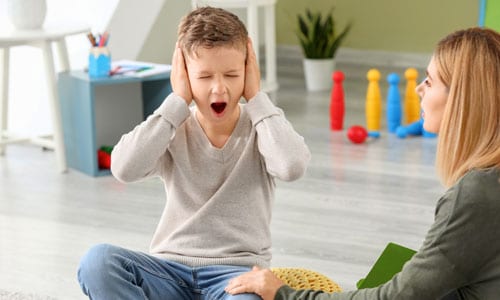
Emotional dysregulation has long been associated with ADHD and is considered a core symptom. It leads to those who suffer from the condition being flooded with high-intensity emotions, which, in turn, can impair their decision-making process and capacity for rational and empathetic thinking.
However, emotional dysregulation has often been overlooked and sometimes misrepresented as a credible symptom in some psychological literature. In the past, this has been one of the primary factors leading to people with ADHD being misdiagnosed. As emotional dysregulation presents as a symptom of other mental health disorders, such as depression, bipolar, borderline personality disorder and PTSD.
ADHD And Emotional Dysregulation (What You Need To Know)
Part of the confusion around emotional dysregulation and ADHD owes to it being included in earlier versions of the Diagnostic and Statistical Manual of Mental Health and its subsequent removal in the 1970s. This was due to the symptoms of hyperactivity and impulsivity being easier to both measure and develop treatments for in a clinical/laboratory setting. And so, the focus of treatment and research was anchored more within the cognitive side of the condition.
As a result, it created a situation where emotional dysregulation is very much a known factor of ADHD. However, as it was phased out of the accepted medical description of the condition, it has since led to ongoing research examining how emotional dysregulation fits into the profile of a modern diagnosis of ADHD. However, while this discussion is taking place, the symptom continues to present consistently in a therapeutic setting.
In fact, many adults who suffer from the condition consider emotional dysregulation to be a significant part of their experience. And much of the narrative around emotional dysregulation in recent years has been around the incomplete framing of ADHD as a condition solely rooted in cognitive symptoms. These include distractibility, organisational problems and memory issues.
It’s been suggested these cognitive symptoms present – at least in part – in those with ADHD because of an inability to regulate certain brain functions. This can then lead to a higher incidence of emotional dysregulation because of the inability to regulate on a cognitive/mental level which, in turn, creates difficulties regulating on the emotional level, also.
Definition of Emotional Dysregulation In ADHD
The issue with emotional dysregulation within ADHD isn’t whether it’s a valid experience, as the presence of the symptom has been a constant since formal research began. The question of emotional dysregulation is how it relates to the condition of ADHD itself, and how it potentially inter-functions as both a symptom and a co-occurring condition. This is an important distinction to make, as it may influence how both symptom sets can be treated most effectively.
For example, if you have a diagnosis of addiction that co-occurs with depression, these are two very separate disorders that require their own treatment plan. Each condition has its own unique symptoms that need to be addressed in a specific order. And so, if there’s a potential ADHD and emotional dysregulation – despite appearing symptomatic in a majority of cases – are actually independent of one another in some cases, it may be that a more proactive approach would be to treat them, individually.
A recent study goes some way to backing up this theory. In a double-blinded clinical trial of 1,490 with ADHD, it was found 73% of people who participated displayed emotional deregulation of part of their symptoms. Conversely, this means 27% of those in this study did not display those symptoms. This can be read in two ways.
Given 73% did experience emotional dysregulation, it indicates enough of a majority that emotional dysregulation might be considered as a symptom. However, in re-framing the data from the perspective of the 27% who didn’t experience emotional dysregulation, it could be suggested that emotional dysregulation might be co-occurring in some cases within the pool of 73% who did experience emotional dysregulation.
This isn’t to demean or diminish the symptom of emotional dysregulation, but simply to suggest that in some cases, it might be worth isolating the symptom sets of emotional dysregulation and ADHD. It might be that a more focused approach in treating the symptoms as separate – but very much related to one another – could yield better outcomes for certain individuals.
Models Of Emotional Dysregulation Within ADHD
Here are three models of how emotional dysregulation might potentially inter function with ADHD based on current research:
- Emotional dysregulation is a core symptom of ADHD and has just as much impact as other behavioural symptoms such as hyperactivity, impulsivity and inattention.
- Emotional dysregulation is seen as a co-occurring and co-morbid condition within ADHD and relates to a form of genetic patterning in the individual.
- The symptoms of both ADHD and emotional dysregulation are separate but related to similar dimensions in the brain and are linked through an overlap in certain deficits within the brain.
The Probable Cause of Emotional Dysregulation in ADHD
The part of the brain responsible for regulating emotional reactions and decision-making is the amygdala. If someone with a healthy functioning brain experiences anger, sadness, or another heightened emotion, the amygdala relays a message to the cerebral cortex. This then lessens the emotional response, allowing for clear thought and an appropriate emotional response to the situation. So, as your cognition is uninhibited, you’re able to respond in a regulated expression.
However, in those with ADHD, the connection between the amygdala and the cerebral cortex is quite weak. This can lead to emotional reactions that don’t align with the nature of a situation. It can also make it extremely challenging for people to bring their emotions back down to a manageable level once the emotional dysregulation has taken hold. It can also see people dissociating and becoming less aware of how their actions may be affecting others.
ADHD Symptoms of Emotional Dysregulation
Emotional dysregulation is a term used to describe a heightened and oftentimes inappropriate reaction to an event or interaction. These events or interactions will often serve as “triggers,” leading to reactions that don’t fit the situation. These can include:
- Emotional reactions that are overblown compared to what caused them
- Difficulty regulating emotions even when the problem has been resolved
- Having a very low tolerance threshold for frustrations and inconveniences
- Displaying temperamental characteristics and frequent outbursts (emotional impulsivity)
- Experiencing difficulty concentrating once the emotional dysregulation has taken hold
ADHD Emotional Dysregulation Examples
The type of events and situations that serve as triggers for emotional dysregulation in ADHD will depend entirely on the individual. Given there is an underlying lack of capacity in navigating perceived setbacks in many people with ADHD, it can be extremely dysregulating when this experience relates to core needs going unmet.
Example of Emotional Dysregulation and ADHD In Children
If a child is looking forward to a day out to the cinema or loves playing Fortnite, and either one or both of those experiences are taken away from them, this could lead to severe emotional dysregulation. Their core need/desire is taken from them. This state of deregulation can be further heightened if either one or both of those needs go unmet as the result of punishment.
Example of Emotional Dysregulation and ADHD In Adults
If an adult who suffers from ADHD is running late for work, has a long commute and finds themselves stuck in traffic, this could serve as a trigger for patterning of dysregulation. Their core need is to get to work on time. And if everything is preventing them from fulfilling that core need for themselves, it can lead to their own patterns of dysregulation occurring.
ADHD Emotional Dysregulation In Relationships
One of the areas where emotional dysregulation can be most problematic is within relationships. When emotions are unable to be properly regulated, it can lead to those with ADHD reacting too intensely, too impulsively and out of proportion relating to the present situation. And so, when these reactions are directed at those who they’re in close contact with, it can lead to increased tensions.
This form of emotional intensity can have a heavy impact on relationships with friends, coworkers, family, and romantic partners. And over time, if left untreated, it can lead to constant dysfunction and a destructive dynamic that can – and often does – end relationships. Some of the challenges relating to emotional dysregulation in those with ADHD include rejection sensitivity, emotional outbursts and impulsive reactions.
Here are 3 ways emotional dysregulation can present in a relationship context in ADHD:
1.ADHD And Rejection Sensitivity
This form of emotional dysregulation relates to criticism. It doesn’t matter if the criticism is delivered in a constructive manner, or in a more attack-minded/toxic expression. For the person with ADHD, it will be received in much the same way. It will still result in a state of emotional dysregulation because the brain is unable to process the incoming information.
When criticism is received, it’s interpreted as a feeling of being unsafe. This can cause those who experience the pattern of rejection sensitivity to feel on edge or stressed about being criticised. So when criticism is received, it can lead to a state of feeling emotionally overwhelmed. This can then lead to a state of panic, impulsive reactions, and dissociation which leads to shutting down.
Being so hypersensitive to the potential of receiving criticism, whether it’s constructive or not, can result in an underlying state of high anxiety. This can make communication around certain pieces relating to boundaries and needs difficult to address, as the expression of boundaries often has an undercurrent of constructive criticism. So as the person with ADHD shuts down, so do the lines of communication.
This can lead to feelings of neglect, for the opposite partner who is receiving the emotional distancing and dissociation. If this pattern continues without any form of intervention, it can have a dramatic effect on emotional intimacy and trust within the relationship. It can lead to a cycle of push and pull, which can be both disorientating and fatiguing for both people involved.
2.Impulsive Outbursts and Unregulated Anger
Anger is one of the most destructive emotions if left unregulated. When unchecked anger is projected onto another person – or group of people – it can create massive schisms in those relationships. When the predominant pattern of dysregulation in ADHD is rooted in anger, it can make those people who receive those projections to feel unsafe, causing them to suppress their own emotions and needs in order to avoid confrontation.
Anger can present in varying levels of intensity and frequency. It’s very much dependent on how severe the case of ADHD is and how prone they are to being triggered. Another factor is how often this person might be exposed to stressors and potentially triggering events, relating to people, places and events – and non-events – that might lead to an episode of dysregulation.
The impulsivity of ADHD coupled with an angry expression of emotional dysregulation means there can be a sharp and sudden rise in frustration when something doesn’t go according to plan. This can lead to shame, blame, and guilt. And it’s these projections onto those people who are closest that can result in a cycle of dysfunction within all types of relationships.
3.Impatience and Demanding Behaviours
Another expression of impulsivity leading to emotional dysregulation can be rooted in instant gratification. This can also have links to rejection sensitivity. For example, if the individual with ADHD desires to resolve a conflict and their partner is unwilling, it can escalate tensions within the dynamic. It can also lead to the person with ADHD pushing their partner to have this conversation, thus overstepping their boundaries by doing so.
While communication is necessary and a foundational component of all healthy, co-creative relationships, there has to be agreement on both sides. If the individual with ADHD who’s displaying impatience and demanding behaviours continues, it can lead to their partner building resentment and anger over time as their boundaries are continually disrespected and overstepped.
These behaviours often tend to manifest more in romantic relationships, as there is far more charge and polarity present. It’s less likely, but not completely out of the question, that this pattern might play out in a work environment. Given there are more structured boundaries within the workplace – and with the consequences being so clear – it can be easier to maintain a sense of regulation in the settings. Although each individual is unique in their cues.
Coping Strategy
The key to finding a sense of regulation always begins with the willingness to look at yourself, and the development of greater self-awareness relating to patterns, triggers, and cues. At present, the current model for emotional regulation comprises five key areas. These are:
- Being able to recognise and own your emotions (so you don’t project them onto others)
- Being able to recognise the emotions in other people (developing a sense of greater empathy)
- Improving emotional reactivity (the emotional threshold and capacity you’re able to hold without reacting and projecting onto others)
- Being able and developing the capacity to calm yourself down either for self-regulation practices or co-regulation practices if the availability of support is there)
- Being able to improve your mood, which can be known as emotional generation
Treatment
There’s a broad spectrum of treatments relating to emotional dysfunction within ADHD. Given that the condition takes root during childhood and can last into adulthood for around 30% of those who receive a diagnosis, treatment plans will vary. This also will depend very much on the needs of the individual.
In the case of children, a combination of behavioural therapy, medications and training for parents to understand the biology of their condition, so they can respond constructively is generally considered the best path to take. It’s also important to be aware, treatment plans will look quite different for children under the age of six and children over the age of six and moving into adolescence.
Treatment plans for adults with a diagnosis of ADHD can also include medication, psychotherapy, education, training or a combination of treatments depending on the individual’s needs. The talk-based psychodynamic therapies that have been proven to be most effective for ADHD in adults are cognitive behavioural therapy (CBT), and dialectical behavioural therapy (DBT).














